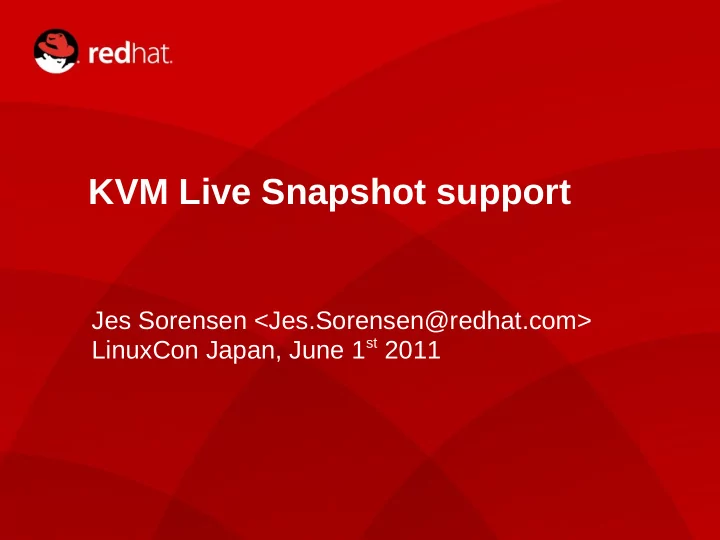

KVM Live Snapshot support Jes Sorensen <Jes.Sorensen@redhat.com> LinuxCon Japan, June 1 st 2011 1
Agenda Snapshot overview QEMU snapshots What is next 2
Definitions ● Snapshot vs “check point - restart” ● A check point operation saves the entire system state, including guest memory, processor state, etc. ● A snapshot creates a coherent copy of a number of block devices at a given time. ● Live snapshot if a snapshot taken while a virtual machine is running. This presentation is about live snapshot support! 3
Snapshot 101 ● Usage / why snapshots? ● Ideal for live backup of guests, without guest intervention (kinda sorta) ● Disk level roll-back, ideal for system upgrade testing etc 4
Snapshot types ● COW vs full snapshots: ● Copy-On-Write snapshots creates a new 'root' block device, referencing original device. Original device becomes 'read-only' ● Variation “referenced” snapshot: binary tree based storage, such as btrfs: data written to new blocks. Snapshot by copy tree structure – once released, unused data blocks are deleted ● Full snapshot creates a full copy of block device, original device no longer referenced 5
System example 6
Snapshots in the I/O stack ● The snapshot operation can be performed at multiple levels of the I/O stack: ● QEMU snapshots ● QCOW2, QED ● LVM ● File system snapshots ● btrfs ● Enterprise storage snapshots ● NFS, NetApp, EMC etc. Note: All examples are for storage attached to the host 7
Snapshot management ● Guest collaboration (agents) ● Coherent API handling all types of media/snapshot mechanisms ● Collapsing/merging snapshots ● QEMU Live block copy 8
Guest collaboration ● Agents ● Guest applications flush data to disk prior to snapshot ● Optimize 'validity' of backup ● Valid for traditional backups as well ● File system freeze ● Make guest file systems coherent (clean) before snapshot is issued ● Linux guests 'virtagent', work in progress ● Windows: VSS ● Note guest collaboration can only ever be best effort! Guests cannot be trusted! 9
Managing snapshots ● Coherent API for snapshot management: ● libvirt ● To issue snapshot, management tool needs to know: ● Storage devices available (QCOW, BTRFS, LVM, enterprise, etc) ● 'driver' for each device ● Preferred storage device for snapshot (if multiple layers can do snapshot) ● Naming conventions ● Expected output device 10
Agenda Snapshot overview QEMU snapshots What is next 11
QEMU snapshots ● Based on COW images ● References back to previous block image (file, raw device, LVM volume etc.) ● Supports snapshot of any block format, including raw devices into QCOW2 or QED ● Results in chain of cow images ● Snapshot of snapshot of snapshot of snapshot....... ● Potential performance issue 12
Snapshot chain 13
Requirements ● Support existing file formats ● Support QCOW2 on raw block devices or LVM ● Simple to use ● Fast ● Support for snapshot of multiple block devices in parallel 14
Overall snapshot flow 15
Implementation ● Implemented by refactoring existing external snapshot code used by qemu-img ● One device at a time ● Multiple devices supported by pausing QEMU during snapshot operation ● Allows for pre-created target image, or QEMU will create it ● Human monitor command: snapshot_blkdev device [new-image-file] [format] ● QMP command ● In progress / under discussion 16
QEMU flow of live snapshot 17
virtagent features ● Added support for ● fsfreeze ● Freezes all file systems, marking them 'clean'. All writes to a frozen file system will block/sleep ● fsthaw ● Thaws all file systems, allowing pending writes to continue ● Requires careful handling as any write to a frozen file system will cause process to sleep! ● No logging from guest agent during freeze! 18
Agenda Snapshot overview QEMU snapshots What is next 19
What is next ● Support asynchronous parallel snapshots ● Will require pre-created target image ● virtagent guest application call-out API ● Notification prior to snapshot, allowing application to write out buffers to disk ● Notification upon snapshot completion, for application to continue normal operation ● libvirt support (in progress) ● Support for multiple backends (QEMU, btrfs, LVM etc.) ● Higher level management tools to use libvirt API 20
Conclusions ● It works! ● Performance is very reasonable, despite simple implementation ● Once file systems frozen, guests quickly stall ● Still more work to be done for asynchronous support ● More work to be done in management layers 21
Questions ? 22
Recommend
More recommend